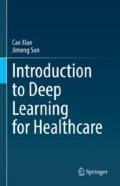Abstract
Machine learning has changed many industries, including healthcare. The most fundamental concepts in machine learning include (1) supervised learning that has been used to develop risk prediction models for target diseases and (2) unsupervised learning that has been applied to discover unknown disease subtypes.
Access this chapter
Tax calculation will be finalised at checkout
Purchases are for personal use only
Notes
- 1.
Maybe a confusing name as logistic regression is for classification not for regression. But the naming choice will become meaningful after we explain the mathematical construction.
- 2.
This means U⊤U = I where I is the identity matrix.
References
J. Davis, M. Goadrich, The relationship between precision-recall and ROC curves, in Proceedings of the 23rd International Conference on Machine Learning, ICML’06 (ACM, New York, 2006), pp. 233–240
L. Khedher, J. Ramírez, J.M. Górriz, A. Brahim, F. Segovia, Early diagnosis of alzheimer’s disease based on partial least squares, principal component analysis and support vector machine using segmented MRI images. Neurocomputing 151, 139–150 (2015)
L. Li, W.-Y. Cheng, B.S. Glicksberg, O. Gottesman, R. Tamler, R. Chen, E.P. Bottinger, J.T. Dudley, Identification of type 2 diabetes subgroups through topological analysis of patient similarity. Sci. Transl. Med. 7(311), 311ra174–311ra174 (2015)
Y. Sasaki, The truth of the F-measure. Teach Tutor Mater (2007)
T. Tantimongcolwat, T. Naenna, C. Isarankura-Na-Ayudhya, M.J. Embrechts, V. Prachayasittikul, Identification of ischemic heart disease via machine learning analysis on magnetocardiograms. Comput. Biol. Med. 38(7), 817–825 (2008)
C. Xiao, P. Zhang, W.A. Chaovalitwongse, J. Hu, F. Wang, Adverse drug reaction prediction with symbolic latent dirichlet allocation, in Proceedings of the Thirty-First AAAI Conference on Artificial Intelligence (AAAI) (2017)
Author information
Authors and Affiliations
Rights and permissions
Copyright information
© 2021 The Author(s), under exclusive license to Springer Nature Switzerland AG
About this chapter
Cite this chapter
Xiao, C., Sun, J. (2021). Machine Learning Basics. In: Introduction to Deep Learning for Healthcare. Springer, Cham. https://doi.org/10.1007/978-3-030-82184-5_3
Download citation
DOI: https://doi.org/10.1007/978-3-030-82184-5_3
Published:
Publisher Name: Springer, Cham
Print ISBN: 978-3-030-82183-8
Online ISBN: 978-3-030-82184-5
eBook Packages: Computer ScienceComputer Science (R0)

